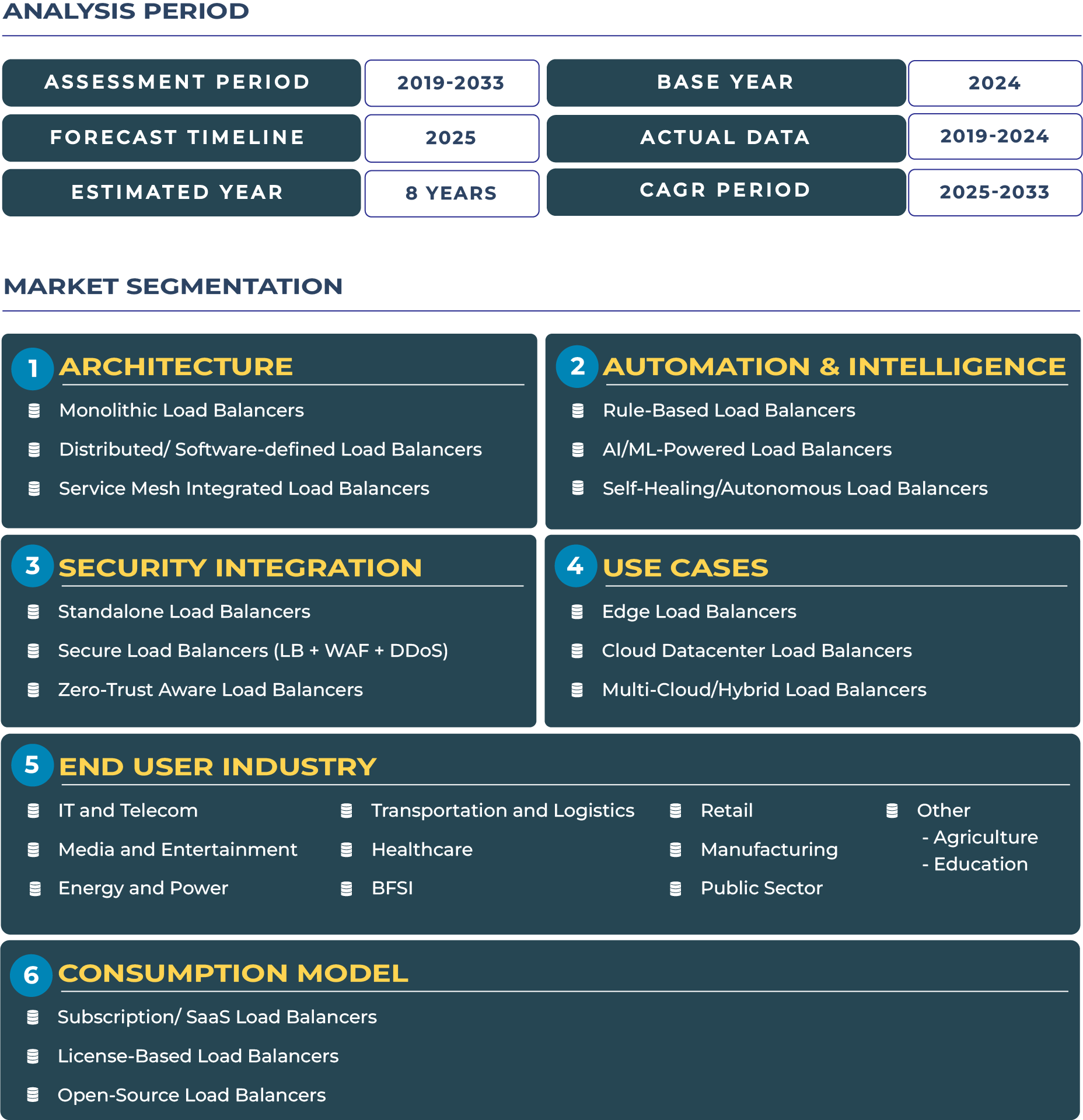Report Format:
![]()
![]() |
Pages: 110+
|
Pages: 110+
Resilient Cloud Growth with SME and Telecom Backbone: Market Outlook for Spain Cloud Load Balancers
Spain is emerging as a resilient digital economy where SME digitization and telecom-led cloud integration form the backbone of its transformation. The interplay between telecom operators, cloud providers, and small businesses is shaping the demand for advanced load balancing solutions that can ensure scalability and security. The Spain Cloud Load Balancers Market is projected to grow from USD 58.3 million in 2025 to USD 179.1 million by 2033, registering a CAGR of 15.1% during 2025–2033. This growth reflects the country’s strategic focus on telecom-cloud synergies, the modernization of core sectors such as tourism and retail, and the acceleration of EU-supported recovery initiatives. With distributed and software-defined load balancers enabling hybrid workloads, Spain’s market outlook is marked by digital resilience, efficient traffic management, and sector-specific adoption patterns that strengthen its cloud ecosystem.
Government-Led Digitization and Sectoral Cloud Integration Driving Growth
The Spanish government’s digital transformation agenda continues to push enterprises toward cloud-native environments, encouraging public and private sector organizations to adopt secure and scalable load balancing solutions. SMEs across Spain, particularly in regions like Catalonia, Madrid, and Valencia, are integrating digital workloads with distributed and software-defined load balancers to scale e-commerce and retail platforms. Furthermore, Spain’s tourism and hospitality sector—a key pillar of its economy—is increasingly migrating workloads to the cloud to ensure responsive customer experiences during peak demand seasons. Hyperscaler investments in Spanish data center regions have also boosted enterprise confidence in deploying advanced load balancing architectures that improve uptime and service continuity.
Economic Volatility and Energy Costs as Market Barriers
While Spain cloud load balancers sector holds promising prospects, economic and structural barriers continue to restrain full-scale adoption. Persistent unemployment challenges and cyclical economic volatility influence IT spending patterns, especially among SMEs in non-urban regions. The surge in energy prices across Europe adds cost pressures for data center operations, impacting the affordability of high-performance load balancing deployments. Additionally, geopolitical uncertainties within the European Union and dependency on imported energy increase financial strain on both telecom operators and digital infrastructure providers. Monolithic load balancers, though still present in legacy setups, are often viewed as inefficient under these conditions, driving a need for more sustainable and distributed architectures but slowing transitions for resource-constrained enterprises.
Sector-Specific Trends and Emerging Opportunities in Spain Cloud Load Balancers Market
Spain cloud load balancers landscape is being shaped by sectoral trends that reflect its diverse economic structure. In retail, hybrid workloads combining online and in-store systems are creating demand for distributed load balancers that guarantee consistent performance. The tourism and travel sector, central to Spain’s global positioning, is digitizing customer experiences through cloud-native platforms that require real-time traffic management. The public sector is also expanding adoption, with e-government services and healthcare workloads demanding resilient service mesh integrated load balancers to enhance availability. Opportunities lie in expanding e-commerce workloads, where distributed balancing enables high-volume transactions; in tourism digitalization, where peak demand scenarios require elasticity; and in government contracts focused on cloud-first IT modernization. These opportunities highlight how Spain’s unique sectoral dynamics reinforce the role of cloud load balancers in scaling national competitiveness.
Competitive Landscape: Strategic Moves in Spain’s Cloud Load Balancers Industry
The competitive dynamics of the Spain cloud load balancers industry are being redefined by both international hyperscalers and local operators. In 2023, AWS launched its Madrid cloud region, expanding the availability of advanced balancing services tailored to high-traffic workloads in retail and travel. In 2024, Microsoft announced new investments in Spanish infrastructure to support hybrid cloud services for enterprises across key industries. Meanwhile, Telefónica has strengthened partnerships to provide integrated telecom-cloud offerings, embedding load balancing solutions as part of its digital services portfolio. These strategic moves are targeted at capturing demand from SMEs, retail platforms, and Spain’s global tourism sector, where reliable and secure workload distribution is critical for sustained competitiveness. The sector continues to evolve as distributed and service mesh load balancers gain prominence, allowing enterprises to deploy scalable solutions in multi-cloud environments.







